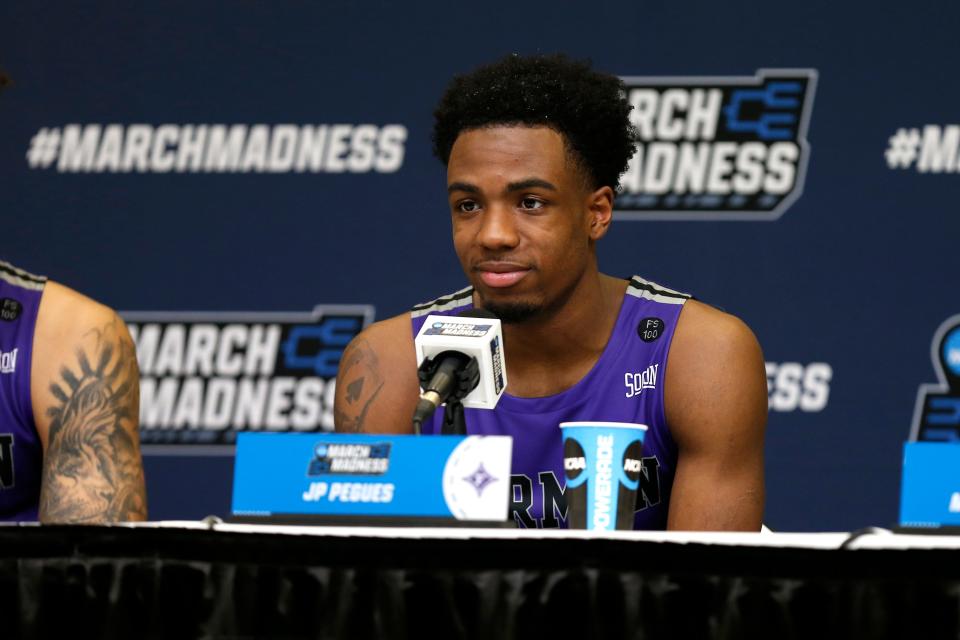JP Pegues by the numbers: A dive into what the transfer is bringing to Auburn basketball
AUBURN — JP Pegues won't be the last piece Auburn basketball adds this offseason, but he may be the most impactful of the bunch.
Pegues, a transfer point guard who's spent the last three seasons at Furman, committed to the Tigers on Friday. His acquisition was made official that evening, with coach Bruce Pearl explaining what made Pegues an attractive option to replace Aden Holloway and Tre Donaldson.
"JP is a winner," Pearl said. "He is a scoring point guard that has great ability to shoot the basketball. He can score at all three levels, defend and lead. Talking to several great coaches in the SoCon, they unanimously believed he was the best player in their league this season. ... This is a great first step in rebuilding our roster.”
The moves are far from over, but here's a dive into what Pegues is bringing to Auburn in his final year of eligibility:
ONE SIDE: Projecting what Auburn football's offensive depth chart looks like after spring
THE OTHER: Who will start on defense for Auburn football in 2024? Our projections after spring
What JP Pegues did against his best competition
The SoCon had one team make the NCAA Tournament last season — Samford took Kansas down to the wire in the first round — while the SEC saw eight programs reach March Madness, with two advancing to the Elite Eight and one making an appearance in the Final Four. The competition level won't be the same on a game-by-game basis, but Pegues played against enough high-quality opponents last season to make extrapolation possible.
Pegues played in eight games that finished the campaign categorized as Quadrant I or Quadrant II opportunities. His averages in those matchups: 34.5 minutes, 20.4 points, 4.9 assists and 3.8 rebounds, according to College Basketball Analytics. He made 39.5% of his 2-pointers and 37.3% of his 3-pointers. His assist-to-turnover ratio settled on 2.27 and his true shooting percentage finished at 59.4%.
Five of Auburn's rotational players last season had a true shooting percentage above 59% in the 21 games that classified as Quadrant I or Quadrant II tests: Dylan Cardwell (70.5%), Jaylin Williams (61.1%), Chad Baker-Mazara (60.8%), Denver Jones (60.6%) and Johni Broome (59.4%). Donaldson narrowly missed the cutoff at 57.2% and Holloway recorded a 41.7% mark.
Auburn hasn't had a point guard with a true shooting percentage over 59% in Quadrant I and II games since J'Von McCormick during the 2018-19 season (61.4%), though Donaldson also came close as a freshman in 2022-23 (57.7%).
What makes what Pegues did more impressive, though? The usage rates in those games: Pegues in 2023-24 (27.2%), Donaldson in 2023-24 (18.2%), McCormick in 2018-19 (17.4%) and Donaldson in 2022-23 (14.6%). In short: Much more was asked of Pegues than the other two.
Better from the right side
Pegues posted solid counting stats — his 18.4 points per game last season was good for No. 3 in the SoCon and No. 70 nationally — but he wasn't always the most efficient player; there were 11 games in which he turned in a rate below 40% on his attempted field goals. On the flip side, he had 11 games where he shot 45% or better, including seven contests that had him above 50%.
One explanation for the streakiness is the weight that was on his shoulders. His season usage rate was 26.1%, which ranked No. 316 out of the 2,927 Division I players who played at least 314 minutes last season to be eligible for the stat (89th percentile). Some of that pressure should be alleviated at Auburn.
Pegues particularly struggled from the left side of the floor, shooting a combined 24-for-87 (27.6%) from the left corner, left wing, left elbow and left baseline. For comparison, his efficiency on the right side in those same areas was 36-for-93 (38.7%). He made 33 of his 74 triples from the top of the key — that's 11.6% better than the nation's average — but his non-at-the-rim rate in the paint of 33.3% was 7.7% below average.
A look at the defensive end
Pegues wasn't a liability on the defensive end at Furman last season, but he also wasn't a standout. He had a Defensive Bayesian Performance Rating of 0.19, per Evan Miya. That's a stat that reflects the defensive value a player brings to his team when he's on the floor. That mark for Pegues ranked No. 440 out of the 1,108 point guards and shooting guards who logged at least 500 total possessions in Miya's system.
The Paladins, as a team, had defensive issues. Their adjusted defensive efficiency of 107.6 ranked No. 205 nationally, according to KenPom. Every team in the SEC was better than that, including Auburn and its sixth-ranked unit. Pearl and his staff have a way of pulling defensive effort out of rosters; the Tigers have had an adjusted defensive efficiency inside the top 55 in six of the last seven seasons, and it's been inside the top 10 two of the last three campaigns.
Pegues, like the other mid-major transfers Auburn has added in the back court over the last handful of years — Wendell Green Jr. (Eastern Kentucky), Zep Jasper (Charleston) and Denver Jones (Florida International) — will have to assimilate.

Richard Silva is the Auburn athletics beat writer for the Montgomery Advertiser. He can be reached via email at rsilva@gannett.com or on X, formerly known as Twitter, @rich_silva18.
This article originally appeared on Montgomery Advertiser: JP Pegues: What is Furman transfer bringing to Auburn basketball?

